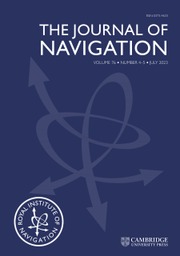No CrossRef data available.
Article contents
Augmented reality projection errors in maritime navigation
Published online by Cambridge University Press: 27 June 2025
Abstract
Augmented reality (AR) is a technology designed to display three-dimensional virtual elements in a real environment. This technology could reduce the cognitive load of marine operators by simplifying information interpretation. However, field tests often reveal qualitative reports of inaccurately projected virtual elements. To address this issue, we present a theoretical model to quantify the error between virtual projections and their observed positions. Numerical simulations, using normal random variables, indicate agreement between the predicted model variance and the error’s standard deviation. Furthermore, a real navigation experiment is conducted where observed errors are inferior to corresponding estimates for error bounds, further indicating the model’s adequacy. The proposed model enables real-time error estimation, system performance prediction and the specification of accuracy requirements. Overall, this study aims to contribute to the systematic definition of accuracy standards for AR-based maritime navigational assistance.
Information
- Type
- Research Article
- Information
- Copyright
- © The Author(s), 2025. Published by Cambridge University Press on behalf of The Royal Institute of Navigation


